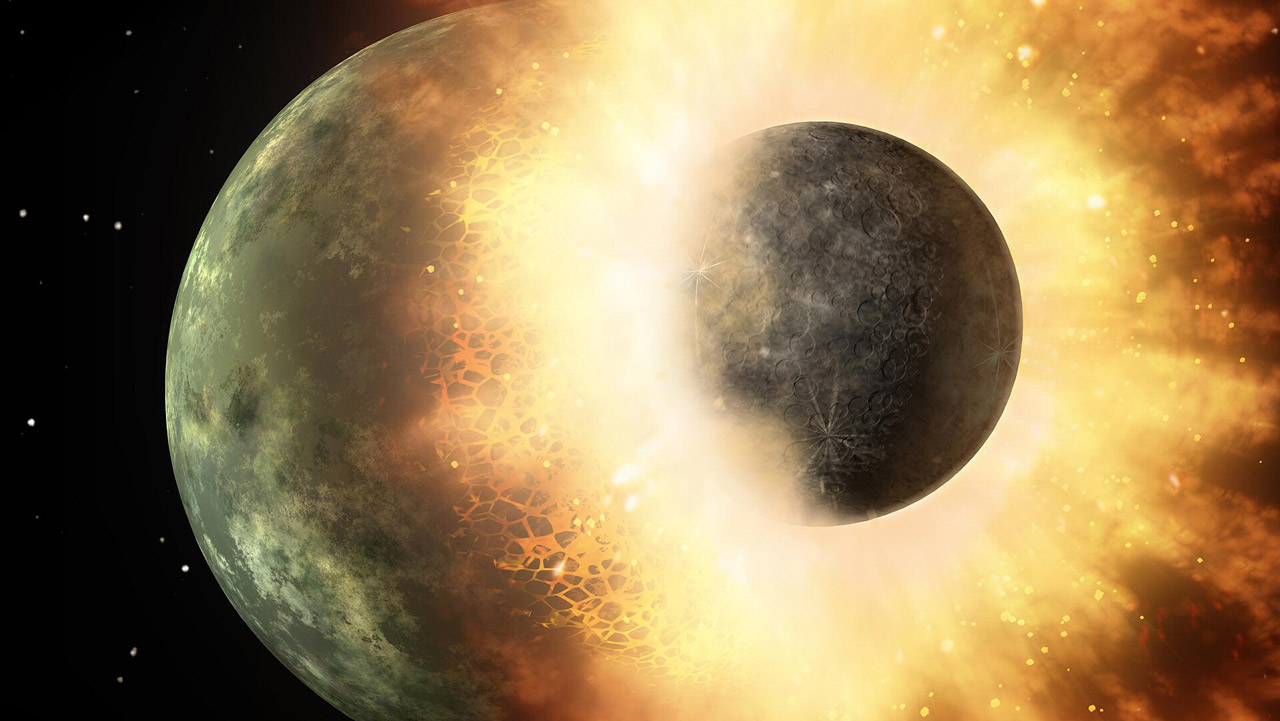Theia

Figure 1. Artist's impression of Theia striking the young Earth.

Figure 2. Hypothetical sequence of events leading to the formation of the Moon.
Over the years, there's been no shortage of ideas about where the Moon came from. Was there once a single body that somehow split in two? Was the Moon formed separately and then captured by Earth's gravity? Or was Earth struck by another object in the remote past, which splashed out material into space that coalesced to make the Moon?
Only the last of these possibilities has stood the test of time. The lunar rock samples brought back by Apollo astronauts have turned out to be very similar in composition to rocks found in Earth's crust, suggesting that long ago they were part of our planet. The collision hypothesis is also the only one that computer simulations have shown to be feasible. Under no reasonable scenarios could an object as large as the Moon have been captured by Earth and ended up in its present orbit, or somehow spun out of it due to rapid rotation.
In one version of the giant-impact hypothesis, a planet about the size of Mars – roughly 6,000 kilometers across – once went around the Sun in a similar orbit to Earth. To begin with, this young planet or proto-planet, moved at one of the stable Lagrange points of Earth's orbit known as L4 or L5 – a third or two-thirds of the way around the orbital path – where, if undisturbed, it could have remained. But it was nudged by the gravitational tug of an embryonic Venus or Jupiter, or both, so that it ended up on a collision course with Earth.
The doomed world, not even a hundred million years old, has been called Theia. In Greek mythology, Theia was one of the Titans. She was the mother of Selene, the goddess of the Moon – and so the name is apt considering the planet Theia's proposed role in creating the Moon.
Around 4½ billion years ago, the theory goes, Theia slammed into Earth, throwing out debris, which then coalesced to form the Moon. The cores and mantles of the two planets fused, providing an explanation of why Earth's core is unusually large for a body of its size. Research published in 2016, which favours a head-on collision between Theia and Earth, rather than a glancing blow, suggests that the intruder was moving no faster than 4 km/s, 14,000 kilometers per hour, when it struck. In 2019 came the suggestion that Theia may have formed, not close to the Sun, but in the outer Solar System. If so, it may have been the source of much of Earth's water and, therefore, an important factor in the origin of terrestrial life.
This whole collision scenario had been circumstantial until new research, published in October 2023, claimed to have found surviving fragments of Theia. They consist of two continent-sized blobs in Earth's mantle about 2,900 kilometers underground beneath Africa and the Pacific Ocean. These blobs, or large low-velocity provinces to give them their technical name, were already known about from seismology but it wasn't clear where they'd come from. The new research, based on computer simulations, offers a solution.
Just before the collision, Earth would have been only about 85% of its present size. The impact would have melted much of Earth and Theia, which combined to form a new, bulkier, Earth. Meanwhile, vast amounts of dust and rock blasted into orbit came together to create the Moon.
According to the simulations, the collision would have melted the upper half of Earth's mantle, allowing a chunk of Theia, perhaps 10%, to penetrate further into the planet and gradually sink towards the core. Over the next 4½ billion years, the rock from Theia could have moved around due to convection currents and formed the blobs we can detect today. The blobs, which are thought to be slightly denser than the surrounding mantle rock, are near the boundary with Earth's core.
To confirm all of this, researchers will need more material evidence, including more lunar samples. Those samples should be forthcoming in the years ahead as space agencies push on with their plans to establish a long-term presence on the Moon.

